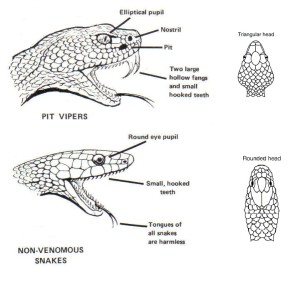With the recent rain and warm weather snakes seem to be literally slithering out of the woodwork. For those out there that are leery of snakes remember that not all snakes are bad. Not every snake is poisonous; some snakes are even good to have around for rodent, insect and critter control.
When you stumble across a snake, the quickest way to tell at a distance if a snake is poisonous or non-poisonous is to notice the shape of the snake’s head. The head of the poisonous snake will be angular (think of a triangle) when compared to the rounder shaped head of non-poisonous snakes. Second thing to notice is whether or not the snake has fangs. A poisonous snake will have fangs with a few teeth versus a non-poisonous snake that has no fangs and many sharp teeth. Third thing to look for if you are still unsure is the snake’s pupils. You will have to get too close for comfort to look but a poisonous snake will have slit pupils versus round eyes, a characteristic of non-poisonous snakes.
Poisonous snakes are classified by being one of two venom types: Hemotoxic venom, which is toxic to the blood, or Neurotoxic venom, which is toxic to the nervous system. All poisonous snakes in Texas, except the coral snake, belong to the pit viper group. Pit vipers include rattlesnakes, copperheads and cottonmouths (water moccasins). Pit vipers inject hemotoxic venom into its victim, while coral snakes inject neurotoxic venom – cottonmouth venom has both. Pit vipers are generally more aggressive in nature than the coral snake and non-poisonous snakes.
When and if you are bitten by a snake, you must remain calm. The more you panic the faster your blood circulates and the faster the venom passes through your body. Next thing you should do is get to an emergency medical facility. (Whether the snake is venomous or not you should seek medical attention since all snakes can carry tetanus.) Try to have a visual description of the snake’s colors/markings if you are unsure of its exact variety since medical treatment will be different for each type of venom. If bitten on an arm or leg you should not elevate above the heart – keep the limb immobilized at a level even with your body, below the heart. Never cut open or try to suck the venom from a wound, it could just spread the poison.

